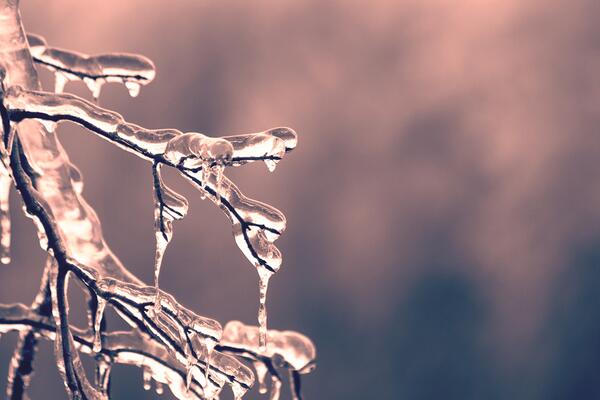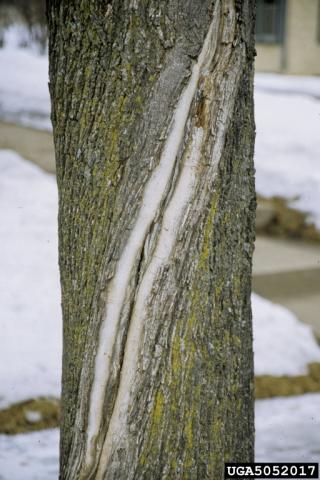
URBANA, Ill. – Winter is hard on trees. Wind, ice, and cold temperatures can harm trees through sunscald, branch-breaking ice loads, or winter burn on evergreens. Taking preventative measures in the fall can help minimize winter injury to trees in the landscape.
Boxwood, arborvitae, and other evergreen species have leaves and needles that transpire water all year long, even in winter. When water exits the plant faster than it is absorbed, winter burn occurs in desiccated needle and leaf tissue. Water loss happens more quickly in windy or sunny conditions, even in low temperatures. Without wind protection, more damage may be noticed on the windward side of the plant, typically the south or southwest.
"When autumn doesn’t provide enough rainfall, deep watering before winter increases moisture to the roots before the ground freezes," says Sarah Vogel, University of Illinois Extension horticulture educator. "You can provide water during brief thawing on warmer days in winter to further lessen winter burn."
A ring of mulch around the base of the plant provides a layer of insulation that helps maintain moisture, reduce drastic soil temp fluctuations, and prevent frost heaving. Mulch should stay a few inches away from the trunk.
Burlap or canvas windbreaks may reduce injury from wind, however, if injury is sustained year after year this greatly impacts the overall health of a plant, and different species may be considered for the site. High levels of stress, such as repeated winter injury, increase susceptibility to biotic pests and pathogens. Anti-desiccant sprays help retain moisture and protect plants from some fungal diseases. Prune away any damaged tissue before new growth emerges in spring.
Another issue is sunscald and frost cracking. Frost cracking occurs when the sun warms bark and outer wood, causing it to expand. In the absence of sunlight, temps cool, and that same tissue will contract. These sudden temperature fluctuations result in vertical fractures along the trunk, called frost cracks.
Sunscald is a result of the same conditions, but causes a different type of damage. Tree cells enter dormancy during winter months. Dormancy can be disrupted by direct sunlight warming cells, only for temps to drop again and kill tree cells.
These phenomena occur in young, thin-barked species such as maple, ash, linden, apple, and peach. Young trees with no barrier from elements are more susceptible. Providing adequate water through fall and winter will help prevent sunscald
Planting trees where they will be protected from the late afternoon sun helps to prevent sunscald and frost cracking. If using tree wrap, apply wraps in November and be sure to remove them in April. Leaving wraps on all year can cause damage or restrict growth.
Winter often brings snow, ice, and high winds which puts branches at risk of breaking. Removing snow loads by shaking branches is not recommended. In fact, it can lead to further damage in frozen, brittle branches. Gently remove snow by using a broom and sweeping upward, but do not stand under the branch. It is best to wait for a warmer day or until the ice melts.
Some trees are more susceptible to broken branches in winter conditions, like multi-stem trees, upright evergreens, and especially trees with included bark from co-dominant stems or narrow branch angles. Prevent storm damage before the risk of breakage is present by pruning deciduous trees while they are young. Remove codominant stems and promote an appropriate scaffolding structure. Avoid pruning late in summer as it promotes new growth that cannot harden off before winter. This can lead to frost damage dieback on branch tips.
If branches break in young trees during a storm, prune them back to the main branch or trunk. Seek help from tree care professionals to prune limbs of larger trees.
Trees are a large part of any landscape and keeping them healthy by using good cultural practices is the best preventative measure against pests, pathogens, and natural disasters. Use these methods to prevent winter damage and protect health of your trees. For more information, review this Trees and winter storm damage article.
For more research-based information on tree care, connect with your local Illinois Extension county office at go.illinois.edu/ExtensionOffice.
ABOUT EXTENSION: Illinois Extension leads public outreach for University of Illinois by translating research into action plans that allow Illinois families, businesses, and community leaders to solve problems, make informed decisions, and adapt to changes and opportunities.
